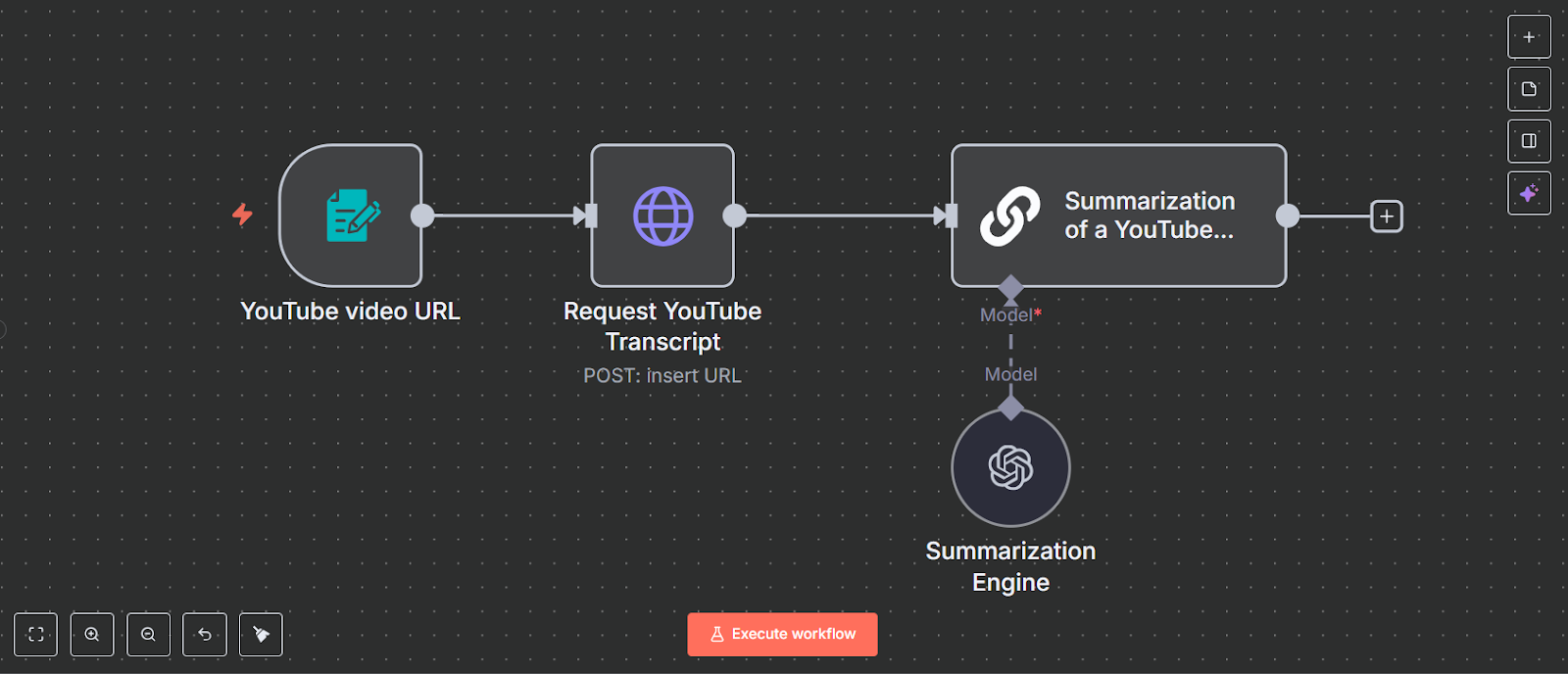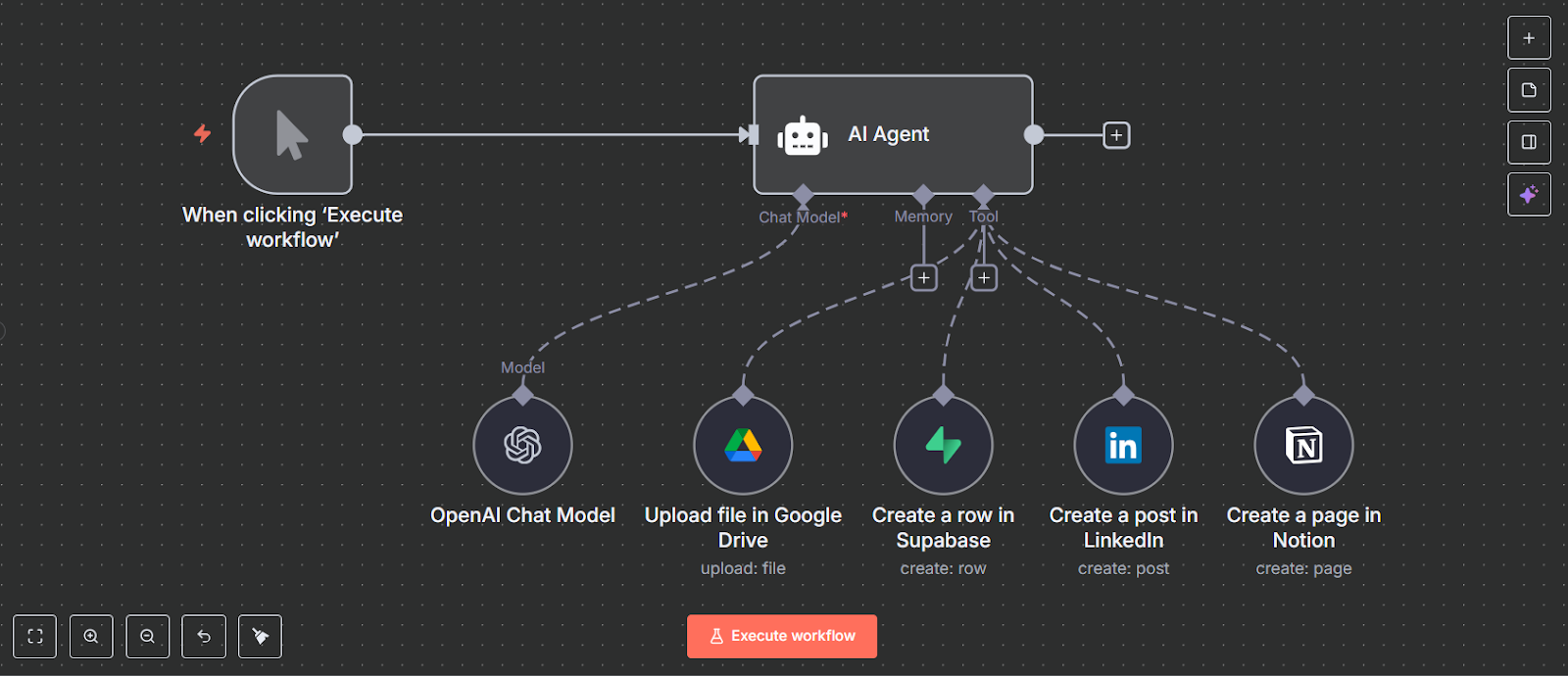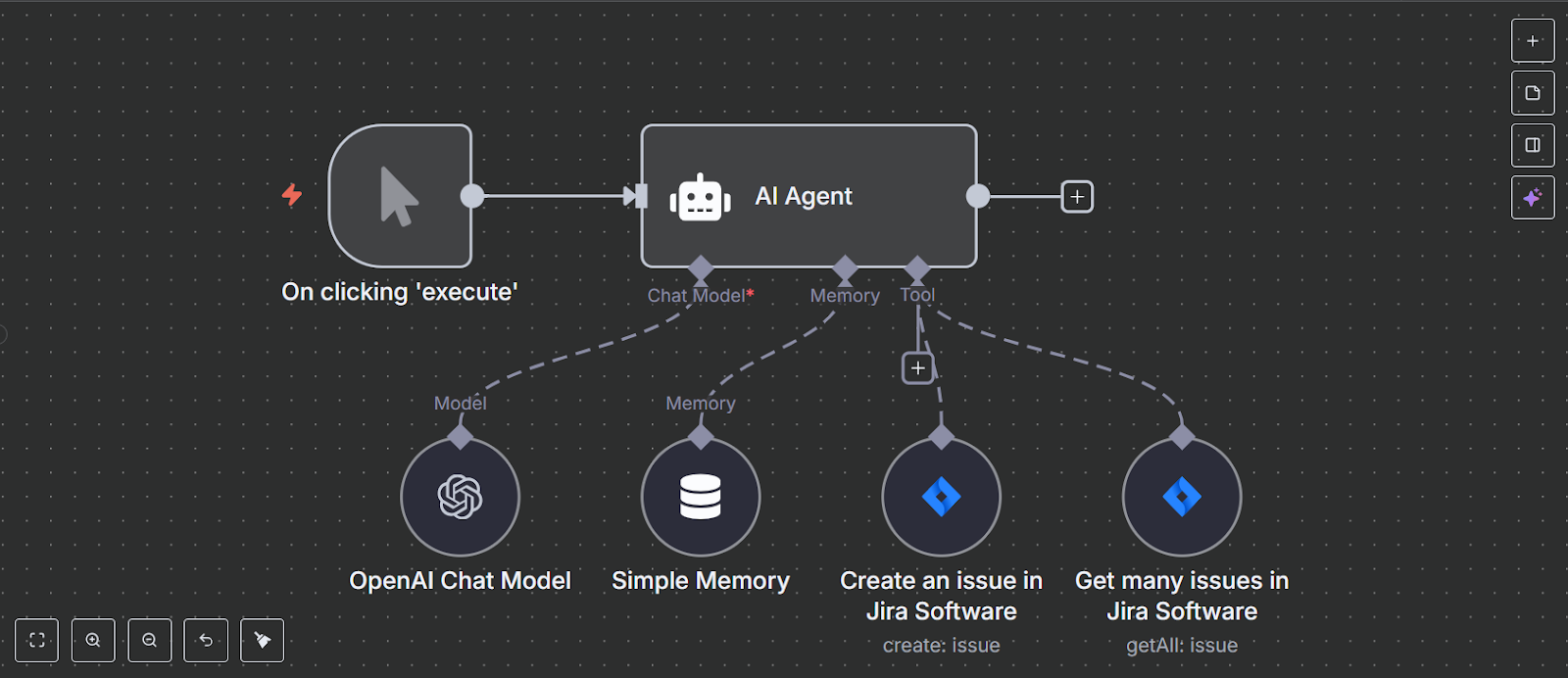Workflow automation isn’t new. Businesses have been using it for years to handle repetitive tasks and improve efficiency. But with the rise of AI, large language models (LLMs), and autonomous agents, we’re seeing a new evolution: agentic workflow automation.
In this article, we’ll share our experience with agentic workflow automation tools, lessons we’ve learned, and how they can improve your business processes.
First, what is workflow automation?
At its core, workflow automation is about replacing manual and repetitive tasks with software-driven processes. Instead of someone clicking through different apps, copying data, or sending routine updates, automation tools handle those steps automatically.

An n8n workflow that automates the process of summarizing YouTube videos. It pulls a transcript from the provided URL and uses the content to generate a summary
Every workflow has a few key components, which are also known as robotic process automation (RPA) tools.
- Trigger: This is the event that starts the workflow, such as a new form submission, a payment received, or a file upload.
- Rules and conditions: These define the logic of the workflow, like “if payment is above $500, then send for approval.”
- Actions: This entails the specific tasks the system carries out, such as sending an email, retrieving information from a knowledge base using retrieval augmented generation (RAG), or calling an API via an MCP server.
- Functions: These are internal, reusable logic, like performing a calculation, converting a file type, or formatting a text before sending it.
- Outcome: This describes the result of the workflow, like a confirmation sent to a customer or updated records in your database.
Platforms like n8n, Make, or Zapier provide a visual interface where you can connect these components into a sequence. In these tools, each component can be represented as a node, which you can link together to build the full workflow.
What is agentic workflow automation, and where does it come in?
Traditional workflow automation is rigid. You predefine a sequence of steps and the exact tool each step will use. The system always follows that path, even if the request could have been handled differently. For example, in a customer support process, if a ticket mentions "password reset," the system automatically sends an email with reset instructions, and if the customer replies again, the ticket is elevated to Tier 2 support. Even if the reply is simply a “thank you,” the workflow still elevates the ticket unnecessarily because it lacks the ability to interpret context or adapt to the situation.
Today, many workflow automation tools now support agentic nodes, which let you add AI agents into the mix. The actions in the workflow remain the same, but now, instead of being locked into one option, the agent can decide which tool to use at each step based on the request or context.
The key difference is that an agent can decide which API to use, while a traditional workflow cannot. If you ask an agent for some information, it determines which API will provide the answer. A workflow, on the other hand, is just a hard-coded script that can’t make that choice independently.
In real-life scenarios, an agent is often connected to multiple tools across the workflow. Instead of being locked into one option, it dynamically selects the right tool to get the job done.
In an agentic workflow, the same customer support process works differently. If a ticket mentions "password reset," the AI agent checks the request, decides which tool to use, and sends the reset email. When the customer replies, the agent interprets the response. If the reply is just a “thank you,” the agent closes the ticket instead of elevating it. But if the customer writes, “The link didn’t work,” the agent can choose another tool, such as generating a new reset link or routing the ticket to live support. This makes the process more flexible, reducing unnecessary elevations while still ensuring issues are handled correctly.
For the scope of this article, we’re focusing on agentic workflows with singular agents. However, thanks to the Agent2Agent (A2A) protocol, you could set up multi-agent systems for deeper collaboration. Learn more in our dedicated article.
How does agentic workflow automation work?
At the core of agentic workflow automation is the agentic node. Inside this node sits an LLM connected to a set of tools it can call. Instead of following a rigid path, the LLM reasons about the user’s prompts, and based on the context, it autonomously decides which tool to use at its point in the workflow.

Here’s how it comes together step by step.
- Workflow still defines the structure. The overall workflow is still built on a platform like n8n. You lay out the main stages: where the automation starts, which tasks need to be done, and what the end result should look like.
- Agentic nodes add flexibility. At certain points, instead of a fixed action node, you place an agentic node. This node has access to multiple connected tools (e.g., CRM, API, document parser, database) and the ability to reason through natural language.
- The LLM makes tool choices dynamically. When the workflow reaches that node, the LLM decides which tool to use based on the context of the request.
- If a candidate submits a PDF resume, the agent might use a document parser.
- If the same candidate submits a LinkedIn URL, the agent might switch to a scraping API.
- The workflow structure doesn’t change, but the execution path does.
- Tools are executed and results fed back. The agent calls the chosen tool, gets the result, and passes it back into the workflow. From there, the automation continues as usual.
- Outcome stays consistent, process adapts. Regardless of the path taken, the workflow still delivers the expected outcome. What changes is the flexibility in how it reaches that outcome.
- Human-in-the-loop adds oversight. Some steps still benefit from human input and intervention. Errors may occur and sensitive actions—like sending offers, updating financial records, or handling edge cases—may require approval before they go through. Human-in-the-loop systems make sure agents stay reliable and accountable, while still removing the bulk of repetitive work.
The agentic approach means that workflows are no longer limited to one “hard-coded” route. The agent sits inside the process as a decision-maker, switching between tools on the fly without requiring the workflow itself to be rebuilt.
Real-world examples from our experience
We’ve seen first-hand how automation can transform day-to-day work when it’s done right. In this section, we’ll share practical examples—from our own experience—where automation solved real problems, saved time, and made our teams more efficient.
Jira automation with AI agents and n8n
Eugene showed how he uses n8n to set up a release note automation that simplify several project management processes, including preparing product release notes.
In the old setup, someone had to log into Jira, search for tickets closed during a release window, read through each description, and then manually compile the notes. This was a repeatable process, but it always required a person to execute it step by step.
With an AI agent, the process looks very different. n8n provides a Jira software node for automating Jira-related tasks. Among other things, this node allows you to create, update, and delete issues. You can also fetch details about existing issues with the Jira query language (JQL), which the Jira node supports.
If someone asks, “Find all issues assigned to me,” the agent node receives the request, interprets it, and passes it to the Jira node. This note then translates it into a JQL search and chooses the right Jira API to fetch the data. It doesn’t just follow a fixed script—it understands the intent and takes the right action.

This flexibility extends further. A request like “Please leave a comment on ticket ‘ABC-123’ saying ‘Test’” is handled by combining the agent with an information extractor node. The extractor identifies the ticket number and the comment text, then passes only the necessary data to the agent. Eugene explained it this way:
“The information extractor collects structured data from a user’s text. While it’s possible for an AI agent to extract information directly, I prefer to use the extractor because it filters out everything except the required information. This approach ensures that only the necessary data is passed to the agent for further processing, reducing the risk of errors or irrelevant data affecting the agent’s decision-making process.”
Once the structured data is ready, the agent then decides to use the Jira API to post the comment without manual input.
Things get more powerful when agents are combined with external systems through webhooks. For example, a webhook can be set up so that whenever someone adds a comment to a Jira ticket, the webhook can trigger the agent to analyze the comment, look up relevant answers from a knowledge base, and respond directly—with zero human intervention required.
Internal talent acquisition: Using AI agents, MS Copilot Studio, and Power Automate to automate job description posts
We’ve also used agentic automation to improve talent management in back-office operations. One example is recruitment. Managers would normally have to manually submit requests through Jira with details of the job openings—salary, location, job description, etc.—they want posted. To simplify this, we used MS Copilot Studio and Power Automate to build an agent and publish it on Microsoft Teams.
Now, a manager can start the process by chatting with the agent directly within Teams—goodbye to switching between platforms. The agent prompts them for the necessary details, such as the role, location, salary range, and other specifications. The agent then automatically creates a job description and submits the request to the Jira Service Desk, reducing the time and effort involved in manual submissions.
The agent taps into internal databases and uses company-approved terminology. This ensures that the job descriptions match our brand guidelines and remain consistent with human-written versions.
Problems and pitfalls to watch out for
Even the smartest automation setup can go off track if you’re not careful. Based on our experience, these are the key areas to watch.
Not putting a human in the loop
One of the biggest mistakes is assuming agents can fully replace human judgment. In reality, certain tasks still need oversight, whether it’s validating outputs, handling exceptions, or making ethical decisions for sensitive scenarios and edge cases.
For example, even though Eugene uses agentic automation to publish release notes and the talent team relies on it to speed up job description creation or IT requests, they review the generated content before it goes live.
Putting a human in the loop ensures that the outputs are accurate, contextually appropriate, and aligned with company standards, while also catching mistakes that automation alone might miss.
Trying to (over) automate everything
Just because you can automate a task doesn’t mean you should. Some processes are too nuanced, context-heavy, or simply don’t benefit from automation. Forcing automation everywhere leads to overengineered systems that are harder to manage than manual work.
Eugene shared the lessons he learned along these lines: "Sometimes when I look back at old workflows, I realize I made them too complicated. With more experience, I’ve learned how to simplify and keep things lean. The challenge is resisting the urge to overengineer."
Consider an expense approval scenario where 90 percent of the expenses are small and straightforward. In this case, building a complex automation with multiple conditional rules, integrations, and notifications may be overkill. It may be better to create a simple rule, like “auto-approving anything under a certain limit,” and elevate to a finance manager for expenses that exceed that limit. This would be easier to manage and just as effective.
Recommendations for getting started with agentic workflow automation
Looking for the best path to follow when setting up agentic workflow automation in your team or organization? Here are some best practices along with expert insights.
Start small, then scale
Begin with small, high-impact workflows before automating everything. This allows you to test your process, gather feedback, and measure results without committing too many resources. Eugene advises, “It’s best to start simple. Tools like Microsoft Power Automate are a good entry point—it’s free, built-in, and comes with a wide range of integrations, even some AI support. It’s not the most advanced solution, but it’s an easy way to start automating everyday tasks."
He also recommends applying automation to personal use cases, not just work-related tasks. "For my personal email, I get a lot of noise—spam, marketing, invoices. But I can’t afford to miss important messages, like salary notifications from my bank. To solve this, I wrote a script that scans my inbox every five minutes. If it sees an email from the bank, it automatically sends me a notification in Telegram."
Know when to use agents instead of static automation
Static automation follows fixed rules, but agents powered by LLMs can make dynamic decisions based on real-time inputs. Use agents when you need flexibility, such as handling varied customer requests, and stick to static automation for predictable, repeatable processes.
Choose the right tool for the job
Not every automation tool is suited for every task. Evaluate options based on integration capabilities, ease of use, and scalability. A simple automation platform may work for basic workflows, while more complex scenarios might require advanced orchestration tools.
Eugene shared his thoughts and factors to consider: "Choosing the right tool is critical. There are many options—n8n, Make, RPA platforms, and more. The key is to evaluate them based on cost, capabilities, and which one gives you the best outcome for your use case."
Set up governance for your automations
As automation grows, governance becomes just as important as the technology itself. To avoid “shadow automations” that no one owns, you’ll need clear rules around ownership, version control, and documentation. Decide who is responsible for monitoring, updating, and securing each process.

With a software engineering background, Nefe demystifies technology-specific topics—such as web development, cloud computing, and data science—for readers of all levels.
Want to write an article for our blog? Read our requirements and guidelines to become a contributor.

